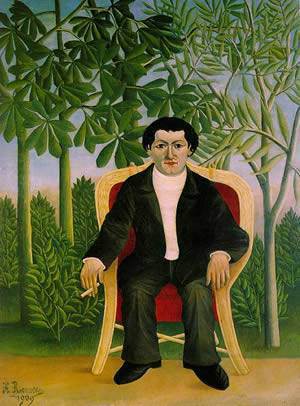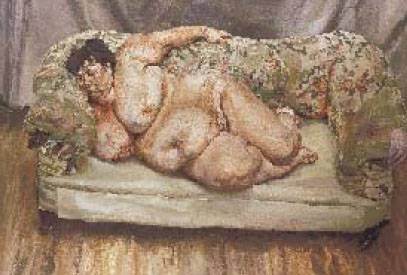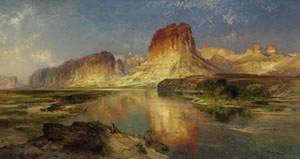
‘Portrait of Joseph Brummer’, 1909 by Henri Rousseau
The Hon. Simon Sainsbury bequeaths masterpieces to the National Gallery and Tate ]]>
29 October 2007, Source: The National Gallery of Art, London
The National Gallery and Tate jointly announced today one of the most significant bequests of paintings ever to the nation.
The collector, Simon Sainsbury (1930-2006), has generously bequeathed 18 paintings from his outstanding international and British art collection to the National Gallery and Tate. Five paintings by artists Edgar Degas, Paul Gauguin, Claude Monet and Henri Rousseau will go to the National Gallery, and Tate will receive 13 works by artists Francis Bacon, Balthus, Pierre Bonnard, Lucian Freud, Thomas Gainsborough, Victor Pasmore, John Wootton and Johan Zoffany.
Martin Wyld, Acting Director, The National Gallery said: “Simon Sainsbury’s legacy at the National Gallery is truly remarkable. He was both a devoted trustee and a guiding force in the successful completion of the Sainsbury Wing. He long intended that major works from his distinguished collection should come to the National Gallery and these outstanding paintings will greatly enrich our Impressionist and Post-Impressionist collection.”
Nicholas Serota, Director, Tate said: “Simon Sainsbury was one of the UK’s most private but generous philanthropists, giving his wealth, time and experience to numerous and varied causes especially in the cultural sector. I am extremely grateful that he chose to bequeath so many remarkable works to the nation. This is one of the most important gifts in the history of Tate and bears comparison with the Frank Stoop Bequest in the 1930s. The sheer variety of works gifted will enhance many different areas of the Tate Collection.”
Works donated to the National Gallery are:
‘Snow Scene at Argenteuil’, 1875 by Claude-Oscar Monet (1840-1926)
Monet was an incomparable painter of snow and this canvas is the largest and most atmospheric of some 18 snow scenes the artist painted in the town of Argenteuil during the winter of 1874-5, famous for its heavy snowfall.
‘Water-Lilies, Setting Sun’, about 1907 by Claude-Oscar Monet (1840-1926)
This vibrant and colourful scene, full of dramatic light effects, depicts a corner of Monet’s water garden at Giverny. Joining twelve other works by Monet in the National Gallery’s collection, it greatly enhances its representation of his audacious late works.
‘Bowl of Fruit and Tankard before a Window’, probably 1890 by Paul Gauguin (1848-1903)
This painting is a statement of Gauguin’s desire to move beyond Impressionism to an art of greater visual complexity and structural vigour. Here he confronts still-life elements in the foreground with a distant view out over a Breton town.
‘Portrait of Joseph Brummer’, 1909 by Henri Rousseau (1844 – 1910)
Joseph Brummer was an early champion of Rousseau’s art, commissioning this monumental portrait soon after meeting the artist. It has long been admired as a masterpiece of European portraiture. The National Gallery’s only other work by Rousseau, ‘Surprised!’, 1891, remains a firm favourite with visitors.
‘After the Bath’, about 1896 by Edgar Degas (1834 – 1917)
Among the most colourful and visually complex of Degas’ late female nudes, this painting profoundly deepens the Gallery’s representation of works by the artist.
Works donated to Tate are:
‘Study for a Portrait’ 1952 by Francis Bacon (1909-1992)
Tate holds some of Bacon’s most important paintings but there are no works by the artist of comparative style and subject in the Collection.
‘The Snack’ 1940, ‘Nude on a Chaise Longue’ 1950 and ‘The Golden Fruit’ 1956 by Balthus (Count Balthasar Klossowski de Rola) (1908-2001)
This is a substantial gift of three major paintings by the artist and will transform Tate’s Balthus holdings.
‘Nude in the Bath’ 1925, and ‘The Yellow Boat’ c.1936-8 by Pierre Bonnard (1867-1947)
These paintings further strengthen his representation making it one of the highlights of the Tate. Although Tate already holds Bonnard’s ‘The Bath’ 1925, ‘Nude in the Bath’ 1925 is a radically different work, by virtue of the inclusion of a self-portrait and its extreme cropping and dynamic vertical format. It provides a greater depth of understanding to the development of this particularly significant theme in his work, while ‘The Yellow Boat’ is a fine example of his late style.
‘Girl with a Kitten’ 1947, ‘Boy Smoking’ 1950-1 and ‘The Painter’s Mother’ 1972 by Lucian Freud (born 1922)
This group of works complements and adds to Freud’s representation in a way that allows the psychological and stylistic shifts in his work during these key years to be traced more adequately. ‘Boy Smoking’, though little known or reproduced, is one of the finest examples of his incisive approach to portraiture in this period and ‘The Painter’s Mother’ is the first painting of the artist’s mother to enter the Collection.
‘Mr and Mrs Carter’ c.1747-8 by Thomas Gainsborough (1727-1788)
This is an important document of the artist’s early career and patronage. It is the earliest painting by Gainsborough to enter the Collection.
‘The Hanging Gardens of Hammersmith, No. 1’ 1944-7 by Victor Pasmore (1908-1998)
The work complements the more abstract and later ‘The Hanging Gardens of Hammersmith’, No. 2 1949 already in the Collection and serves to illuminate the full complexity of his investigation of abstraction.
‘Life-size Horse with Huntsman Blowing a Horn’ c.1732 by John Wootton (?1682-1784)
This is arguably one of the artist’s masterpieces. It is more monumental than the other hunting scenes in the Collection by the artist.
‘Colonel Blair and his Family and Indian Ayah in an Interior’ 1789 by Johan Zoffany (1733-1810)
This is the first conversation piece by the artist to enter the Collection.
A display of the works donated to the National Gallery and Tate Collection will open at Tate Britain on 9 June 2008.
Follow us on:


